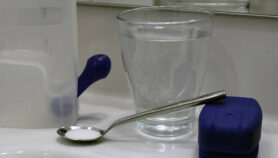01/10/18
Easy sweat-based test for leishmaniasis

By: Sanjeet Bagcchi
Send to a friend
The details you provide on this page will not be used to send unsolicited email, and will not be sold to a 3rd party. See privacy policy.
[NEW DELHI] Indian researchers have developed a non-invasive diagnostic method that relies on human sweat rather than blood samples to detect visceral leishmaniasis, also called kala-azar.
Visceral leishmaniasis, caused by the parasite Leishmania donovani and transmitted by female sandflies, is marked by fever, enlarged spleen and liver, anaemia and weight loss. The disfiguring disease is endemic in over 60 countries across the world with 50,000—90,000 new cases reported annually — 90 per cent of them in Brazil, Ethiopia, India, Kenya, Somalia and Sudan.
“Instead of collecting the blood or separating the serum, we can now use the patient’s sweat in the antigen strips test to diagnose kala-azar or PKDL non-invasively and with almost similar sensitivity and specificity as with the blood- or serum-based tests”
V. N. R. Das, Rajendra Institute of Medical Sciences
The test, capable of diagnosing kala-azar with almost similar sensitivity and specificity as tests based on blood or serum (liquid fraction of blood), is described in a study published online 10 September in the American Journal of Tropical Medicine and Hygiene.
Accurate and affordable diagnosis has been a major barrier in the control of visceral leishmaniasis. The most accurate method, involving fluid from the spleen or bone marrow to demonstrate presence of the parasite, is invasive and requires expertise and laboratory support.
When strips stuffed with antigen from L. donovani come into contact with antibodies developed against the parasite in a patient’s body fluid — blood, serum or sweat — infection is indicated by antigen-antibody reaction showing up as a ‘double red line’ formation on the white strips, explains V. N. R. Das, an author of the study and researcher at the Rajendra Institute of Medical Sciences, Patna.
When sweat samples collected from 58 confirmed visceral leishmaniasis patients were subjected to the antigen strip tests, they showed 96.55 per cent positivity. Similar percentages were obtained using blood samples.
The tests were 100 per cent accurate in the case of patients with post-kala-azar dermal leishmaniasis — a sequel of kala-azar, noted in 5—10 per cent of patients in the Indian subcontinent and east Africa which is marked by rashes on the face, trunk and upper arms.
Das tells Scidev.Net: “Instead of collecting the blood or separating the serum, we can now use the patient’s sweat in the antigen strips test to diagnose kala-azar or PKDL non-invasively and with almost similar sensitivity and specificity as with the blood- or serum-based tests.”
Das admits that further evaluation of the new method on a larger scale would be needed to enhance reliability so that it can be used efficiently in the management and eradication of visceral leishmaniasis.
Swapan Kumar Jana, a senior doctor at the Calcutta National Medical College and Hospital and an expert on kala-azar but isn’t involved in the study, believes that the study is an important milestone against the disease.“Using sweat as the sample in the strips test is a non-invasive diagnostic approach which is painless and easily accessible as compared with blood or serum-based tests, and is effective in remote, endemic areas,” he says.
This piece was produced by SciDev.Net’s Asia & Pacific desk.













